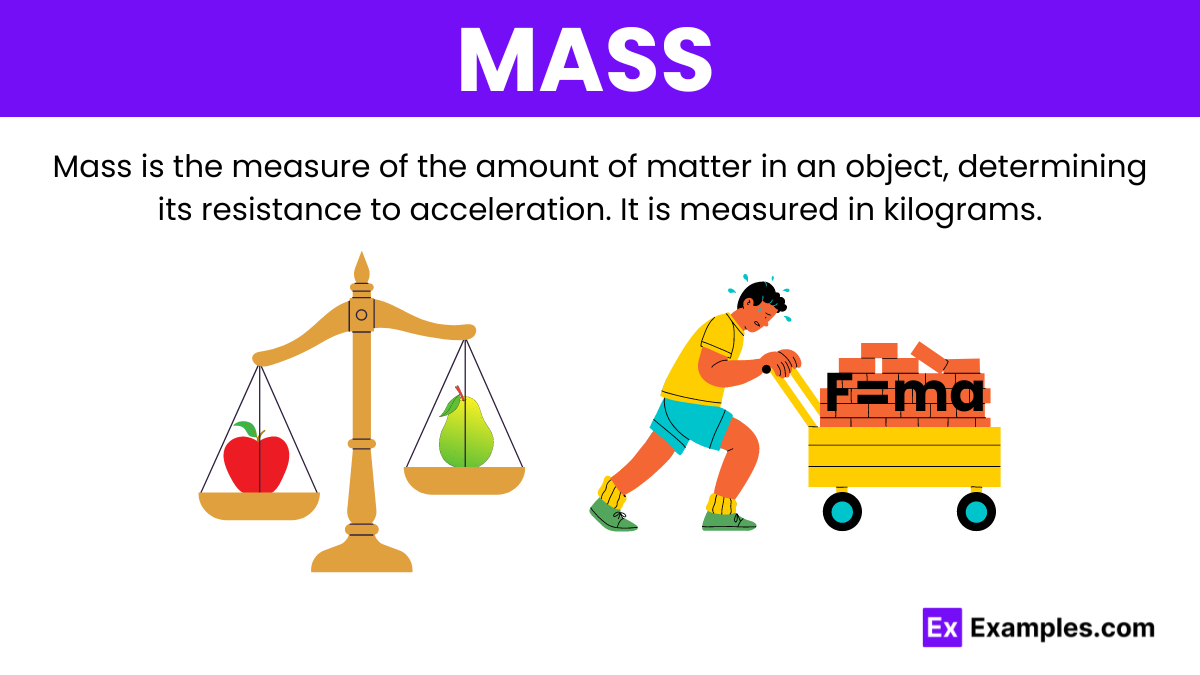What is the SI unit of mass?
Gram
Kilogram
Pound
Ounce


Mass is a fundamental property of physical objects which measures the amount of matter within them. Unlike weight, mass is not affected by gravity. This makes it a consistent property regardless of location.
In physics, mass is a fundamental property of an object and is a measure of the amount of matter it contains. The formula for mass is derived from Newton’s second law of motion, which relates mass, force, and acceleration.
Newton’s second law states that the force applied to an object is equal to the mass of the object multiplied by its acceleration. This relationship is expressed in the formula:
Where:
To find the mass of an object when you know the force applied to it and its acceleration, you can rearrange the formula:
This equation means that the mass of an object is equal to the force applied to it divided by the acceleration it experiences.
Imagine a scenario where a force of 10 newtons is applied to an object, causing it to accelerate at 2 meters per second squared. Using the mass formula, you can calculate the mass as follows:
m = 10N/(2m/s²) = 5 kg
This calculation shows that the object has a mass of 5 kilograms.
Finding the mass of an object involves different methods depending on the context and the available tools. Here are the primary ways to determine the mass of an object:
The most direct method to measure mass is by using a balance scale, which compares the mass of an object to known masses.
This method is highly accurate and is commonly used in laboratories.
A spring scale measures the weight of an object, which can be converted into mass:
For irregularly shaped objects, the water displacement method can determine volume, which can help find mass if the density is known:
If the object is a standard geometric shape and the density of the material is known, you can calculate its volume and then use the density to find the mass:
If you have a cube of metal with each side measuring 2 cm, and the density of the metal is 7.87 g/cm³:
In everyday life, you might use pounds and ounces to measure ingredients in a recipe if you are in the United States. In a scientific lab, you would likely use grams or milligrams to measure chemicals. When buying jewelry, you might consider the carat weight of diamonds and other gemstones.
| Aspect | Mass | Weight |
|---|---|---|
| Definition | Mass is the amount of matter contained in an object. | Weight is the force exerted by gravity on an object. |
| Units | Measured in kilograms (kg) in the SI system. | Measured in newtons (N) in the SI system. |
| Constancy | Mass remains constant regardless of location. | Weight changes with the gravitational pull. |
| Dependency | Does not depend on gravity. | Directly depends on gravitational force. |
| Measurement | Measured using a balance scale. | Measured using a spring scale. |
| Formula | No direct formula, intrinsic property of matter. | Weight = Mass x Gravitational acceleration (W = mg) |
| Example | A person’s mass is the same on Earth and the Moon. | A person weighs less on the Moon than on Earth. |
Text prompt
Add Tone
10 Examples of Public speaking
20 Examples of Gas lighting
What is the SI unit of mass?
Gram
Kilogram
Pound
Ounce
How is mass different from weight?
Mass is a measure of gravitational force
Mass is the same as weight
Mass is a measure of the amount of matter
Mass depends on location
What tool is commonly used to measure mass?
Thermometer
Barometer
Balance
Speedometer
Which of the following quantities is scalar?
Force
Velocity
Mass
Acceleration
If the mass of an object is 10 kg on Earth, what would be its mass on the Moon?
10 kg
1.6 kg
16 kg
6 kg
What is the relationship between mass and inertia?
Inertia is independent of mass
Greater mass means greater inertia
Less mass means greater inertia
Inertia and mass are not related
What happens to the mass of a substance if it is divided into smaller pieces?
The mass of each piece is greater than the original
The total mass remains the same
The total mass decreases
The mass of each piece depends on its shape
Which physical property is directly proportional to mass?
Density
Volume
Weight
Temperature
How is mass measured in the metric system?
Pounds and ounces
Kilograms and grams
Inches and feet
Liters and milliliters
What would be the mass of an object on Jupiter if its mass is 15 kg on Earth?
15 kg
1.5 kg
150 kg
7.5 kg
Before you leave, take our quick quiz to enhance your learning!

